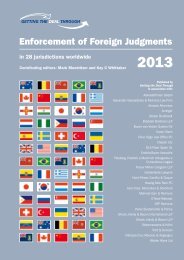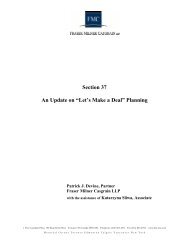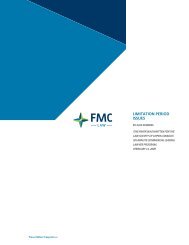Presentation by Mary Picard of Fraser Milner Casgrain LLP to the 9 ...
Presentation by Mary Picard of Fraser Milner Casgrain LLP to the 9 ...
Presentation by Mary Picard of Fraser Milner Casgrain LLP to the 9 ...
Create successful ePaper yourself
Turn your PDF publications into a flip-book with our unique Google optimized e-Paper software.
<strong>Presentation</strong> <strong>by</strong> <strong>Mary</strong> <strong>Picard</strong> <strong>of</strong> <strong>Fraser</strong> <strong>Milner</strong> <strong>Casgrain</strong> <strong>LLP</strong><br />
<strong>to</strong> <strong>the</strong> 9 th Annual National Forum on<br />
Pension Law, Litigation and Governance<br />
This paper will briefly address:<br />
Hosted <strong>by</strong> <strong>the</strong> Canadian Institute in Toron<strong>to</strong>, Ontario<br />
January 30-31, 2008<br />
What is a MEPP? page 1<br />
Demystifying <strong>the</strong> Legal Treatment <strong>of</strong><br />
Multi-Employer Pension Plans: Reducing Risks<br />
How do MEPPs differ from o<strong>the</strong>r, single-employer pension plans? page 2<br />
Quebec exception: MEPP benefits cannot be reduced for Quebec members page 3<br />
What is a SMEP? page 4<br />
What is a SMEPP? page 6<br />
What is a SOMEPP? page 6<br />
Special solvency rules for MEPPs page 7<br />
Participating Co-Ops litigation page 8<br />
CCWIPP litigation page 10<br />
Neville v. Wynne litigation page 12<br />
Reducing Risks page 13<br />
What is a MEPP?<br />
A MEPP is a registered pension plan established through a collective<br />
bargaining process. It covers two or more unrelated employers. A MEPP <strong>of</strong>ten has dozens,<br />
or even hundreds <strong>of</strong> employers participating in a single plan. A MEPP can include both<br />
1 First Canadian Place, 100 King Street West Toron<strong>to</strong> ON Canada M5X 1B2 Telephone (416) 863-4511 Fax (416) 863-4592 www.fmc-law.com<br />
M o n t r é a l O t t a w a T o r o n t o E d m o n t o n C a l g a r y V a n c o u v e r N e w Y o r k
public-sec<strong>to</strong>r and private-sec<strong>to</strong>r employers. It’s common <strong>to</strong> see MEPPs in industries such as<br />
construction trades, retail, transportation, hotel and restaurants, textiles and electricians.<br />
Plan membership usually does not terminate when an employee terminates with one <strong>of</strong> <strong>the</strong><br />
participating employers in a MEPP; an employee could accrue pension credits with many<br />
different participating employers.<br />
It has been estimated that <strong>the</strong>re are approximately 500 MEPPs in Canada with<br />
membership <strong>of</strong> over a million individuals.<br />
How do MEPPs differ from o<strong>the</strong>r, single-employer pension plans?<br />
In <strong>the</strong> case <strong>of</strong> a single-employer plan, typically <strong>the</strong> plan sponsor, <strong>the</strong><br />
employer, is <strong>the</strong> administra<strong>to</strong>r <strong>of</strong> <strong>the</strong> plan. That employer controls all aspects <strong>of</strong> running <strong>the</strong><br />
plan, including investments, record-keeping, benefit payments, etc. The employer delegates<br />
<strong>to</strong> service providers, but <strong>the</strong> employer remains ultimately in control and liable for all aspects<br />
<strong>of</strong> <strong>the</strong> plan.<br />
That is not <strong>the</strong> case with MEPPs. Participating employers in MEPPs do not<br />
administer <strong>the</strong> plan. Their role is limited. The registered administra<strong>to</strong>r <strong>of</strong> <strong>the</strong> MEPP is a<br />
collection <strong>of</strong> appointed individuals called <strong>the</strong> “board <strong>of</strong> trustees”. Usually <strong>the</strong> board <strong>of</strong><br />
trustees is made up <strong>of</strong> both union-appointed representatives and employer-appointed<br />
representatives.<br />
It is generally expected that a participating employer in a MEPP has a limited<br />
role: (a) report <strong>to</strong> <strong>the</strong> MEPP administra<strong>to</strong>r information about <strong>the</strong>ir employees who are<br />
eligible <strong>to</strong> join <strong>the</strong> MEPP, and (b) submit contributions <strong>to</strong> <strong>the</strong> MEPP. Although this is what<br />
- 2 -
is generally expected, it may not be true. The legal obligations <strong>of</strong> <strong>the</strong> participating employer<br />
will depend on <strong>the</strong> terms <strong>of</strong> <strong>the</strong> text <strong>of</strong> <strong>the</strong> MEPP and related contracts, <strong>the</strong> requirements <strong>of</strong><br />
collective bargaining agreements and <strong>the</strong> common law. The litigation described below<br />
demonstrates that participating employers in some MEPPs may be surprised that <strong>the</strong>ir legal<br />
obligations extend beyond <strong>the</strong> obligation merely <strong>to</strong> make contributions and report member<br />
information <strong>to</strong> <strong>the</strong> MEPP administra<strong>to</strong>r.<br />
The most significant characteristic <strong>of</strong> MEPPs is that if <strong>the</strong>y are worded<br />
properly, legislation permits benefits <strong>to</strong> be reduced if <strong>the</strong>re is a deficit; employers are not<br />
required <strong>to</strong> fund <strong>the</strong> deficit. This reduction <strong>of</strong> benefits in a MEPP is specifically permitted in<br />
pension legislation across Canada, with <strong>the</strong> exception <strong>of</strong> Quebec.<br />
Quebec exception: MEPP benefits cannot be reduced for Quebec members<br />
Litigation surrounding <strong>the</strong> Canada-Wide Industrial Pension Plan (“CWIPP”)<br />
illustrates that it may not be permitted <strong>to</strong> reduce <strong>the</strong> benefits in a MEPP that has Quebec<br />
members.<br />
CWIPP was set up for Canada Labour Congress workers. The plan is<br />
registered in Ontario and has more than 100 participating employers with employee<br />
members across Canada. Intersan was, at one point, <strong>the</strong> only participating employer in<br />
Quebec. The trustees <strong>of</strong> CWIPP maintain separate components within <strong>the</strong> plan, allocable <strong>to</strong><br />
each participating employer. The funded status <strong>of</strong> each component varies because <strong>the</strong><br />
benefits vary <strong>by</strong> employer.<br />
- 3 -
Litigation arose when Intersan terminated its participation in CWIPP in 1999.<br />
Because <strong>of</strong> a deficit, <strong>the</strong> board <strong>of</strong> trustees <strong>of</strong> proposed <strong>to</strong> reduce <strong>the</strong> benefits <strong>of</strong> <strong>the</strong> Intersan<br />
members according <strong>to</strong> <strong>the</strong> percentage deficit in <strong>the</strong> Intersan component <strong>of</strong> <strong>the</strong> plan (57.7%<br />
funded). The <strong>to</strong>tal funded status <strong>of</strong> CWIPP at <strong>the</strong> time was 72.9%.<br />
The Quebec pension regula<strong>to</strong>r refused <strong>to</strong> allow <strong>the</strong> benefit reduction and<br />
issued an order stating that <strong>the</strong> Intersan members must be paid 100% <strong>of</strong> <strong>the</strong>ir benefits out <strong>of</strong><br />
CWIPP because Quebec pension legislation forbids benefit reduction, even for MEPPs. The<br />
Quebec regula<strong>to</strong>r required <strong>the</strong> trustees <strong>to</strong> dip in<strong>to</strong> <strong>the</strong> assets allocated <strong>to</strong> <strong>the</strong> remaining<br />
participating employers <strong>to</strong> pay <strong>the</strong> Intersan Quebec members in full. The Tribunal<br />
Administratif du Quebec eventually ruled that <strong>the</strong> terms <strong>of</strong> CWIPP that permitted benefit<br />
reduction were not enforceable under Quebec pension legislation.<br />
What is a SMEP?<br />
A specified multi-employer plan, or “SMEP”, is defined in <strong>the</strong> Income Tax<br />
Act Regulations 1 . It’s a type <strong>of</strong> MEPP. The SMEP designation is desirable for MEPPs<br />
because it will be considered a defined contribution plan for pension adjustments (“PA”)<br />
reporting purposes, even if <strong>the</strong> MEPP promises a defined benefit. A pension plan that does<br />
not qualify as a SMEP under <strong>the</strong> Income Tax Act 2 has <strong>to</strong> report its PAs in <strong>the</strong> same way as<br />
single-employer plans (this generally requires nine times <strong>the</strong> benefit accrued during <strong>the</strong><br />
year).<br />
1 C.R.C., c. 945.<br />
2 Supra, note 2.<br />
- 4 -
To acquire <strong>the</strong> desirable status <strong>of</strong> an Income Tax Act SMEP, a MEPP must<br />
have 15 or more unrelated employers. SMEP designation can apply with fewer employers,<br />
if <strong>the</strong>re is significant movement <strong>of</strong> participants among <strong>the</strong> plan’s employers (<strong>the</strong>re must be at<br />
least 10% <strong>of</strong> <strong>the</strong> active members working for more than one contributing employer during<br />
<strong>the</strong> year). O<strong>the</strong>r requirements <strong>to</strong> be designated as a SMEP include <strong>the</strong> requirement that<br />
contributions be based on hours worked <strong>by</strong> active members. Also, <strong>the</strong> board <strong>of</strong> trustees<br />
administering <strong>the</strong> MEPP cannot be controlled <strong>by</strong> <strong>the</strong> employers.<br />
The Canada Revenue Agency (<strong>the</strong> “CRA”) provides a full list <strong>of</strong> SMEP<br />
requirements in <strong>the</strong>ir technical manual at http://www.cra-<br />
arc.gc.ca/tax/registered/manual/tech-17-e.html#P8_24v. The CRA allows for some<br />
flexibility in designating a plan as a SMEP:<br />
“We only designate a plan <strong>to</strong> be a SMEP if it has satisfied<br />
several <strong>of</strong> <strong>the</strong> characteristics described above and <strong>the</strong><br />
designation is required <strong>to</strong> overcome serious PA reporting<br />
difficulties. Typically, this designation will only be given<br />
when it is reasonable <strong>to</strong> expect that at least 15 employers will<br />
contribute <strong>to</strong> <strong>the</strong> plan in <strong>the</strong> year or at least 10% <strong>of</strong> <strong>the</strong> active<br />
members will be employed <strong>by</strong> more than one participating<br />
employer.” 3<br />
3 “Registered Plans Direc<strong>to</strong>rate technical manual” Canada Revenue Agency (1 November 2005), online:<br />
Canada Revenue Agency < http://www.cra-arc.gc.ca/tax/registered/manual/tech-17-e.html#P8_24v> at 17.2<br />
8510(2).<br />
- 5 -
What is a SMEPP?<br />
The term “specified multi-employer pension plan” (“SMEPP”) used <strong>to</strong> be synonymous with<br />
MEPP. The Alberta Employment Pension Plans Act 4 changed <strong>the</strong> term from MEPP <strong>to</strong><br />
SMEPP in 2000.<br />
What is a SOMEPP?<br />
In August 2007 <strong>the</strong> Ontario government introduced changes <strong>to</strong> regulations under <strong>the</strong> Ontario<br />
Pension Benefits Act 5 <strong>to</strong> create a new breed <strong>of</strong> MEPP called a “SOMEPP” (specified Ontario<br />
multi-employer pension plan). The advantage <strong>of</strong> being a SOMEPP is that special, temporary<br />
solvency funding relief is available. Attached as Schedule A <strong>to</strong> this paper is a description <strong>of</strong><br />
<strong>the</strong> new Ontario SOMEPP rules that appeared on <strong>the</strong> website <strong>of</strong> <strong>the</strong> Financial Services<br />
Commission <strong>of</strong> Ontario in September 2007.<br />
In order <strong>to</strong> qualify as a SOMEPP:<br />
• A pension plan may make an election at any time between September 1, 2007 and<br />
August 31, 2010 <strong>to</strong> be designated as a SOMEPP. The election may be rescinded. If<br />
it is, <strong>the</strong> rescission is permanent, and no future election <strong>to</strong> be treated as a SOMEPP is<br />
permitted.<br />
• Certain criteria must be satisfied <strong>to</strong> qualify as a SOMEPP. The plan must meet <strong>the</strong><br />
criteria for SMEPs under <strong>the</strong> Income Tax Act (described above). Also, <strong>the</strong> plan<br />
terms must permit <strong>the</strong> trustees <strong>to</strong> reduce benefits in <strong>the</strong> event <strong>of</strong> a deficit.<br />
4 R.S.A. 2000, c. E-8.<br />
5 R.S.O. 1990, C. P.8<br />
- 6 -
Notwithstanding SOMEPP designation, <strong>the</strong> plan must continue any existing going-concern<br />
special payments required under any filed valuation reports. Any new going-concern<br />
shortfalls may be funded over a period <strong>of</strong> 12 years. Benefit improvements may be granted,<br />
provided that any improvements are funded on a going-concern basis over a period <strong>of</strong> eight<br />
years (ra<strong>the</strong>r than 12 years), if, after reflecting <strong>the</strong> benefit improvements, <strong>the</strong> plan’s transfer<br />
ration is less than 80%, or <strong>the</strong> plan’s going-concern funded ration is less than 90%.<br />
Note <strong>the</strong> requirement that all plan members, unions and participating<br />
employers be notified <strong>of</strong> <strong>the</strong> fact that <strong>the</strong> plan is being treated as a SOMEPP.<br />
Special solvency rules for MEPPs<br />
All defined benefit pension plans are subject <strong>to</strong> <strong>the</strong> calculation <strong>of</strong> <strong>the</strong>ir<br />
deficit/surplus position based on ei<strong>the</strong>r a “going concern” or “solvency” basis. Pension<br />
plans which are not MEPPs are usually required <strong>to</strong> pay <strong>of</strong>f <strong>the</strong>ir deficit based on <strong>the</strong><br />
“solvency” position.<br />
Does it make sense <strong>to</strong> require a MEPP <strong>to</strong> make contributions <strong>to</strong>wards paying<br />
<strong>of</strong>f a solvency deficit when MEPP benefits will simply be reduced in <strong>the</strong> event <strong>of</strong> plan<br />
termination and deficit? Certain provincial legislatures have responded <strong>to</strong> this question <strong>by</strong><br />
granting “solvency funding relief” <strong>to</strong> MEPPs. The Ontario temporary relief for SOMEPPs<br />
described above is one example. Ano<strong>the</strong>r example is Alberta’s Employment Pension Plans<br />
Amendment Act, 2005 6 and Employment Pension Plans Amendment Regulation, 2006 7 ,<br />
which states:<br />
6 S.A. 2005, c. 26<br />
- 7 -
“The administra<strong>to</strong>r <strong>of</strong> a SMEPP may make a one-time<br />
application <strong>to</strong> suspend solvency deficiency special payments,<br />
for a period <strong>of</strong> no more than three years.” 8<br />
Approval <strong>by</strong> <strong>the</strong> Alberta Superintendent is conditional upon any “going<br />
concern” deficit being amortized over ten years, as opposed <strong>to</strong> <strong>the</strong> usual fifteen-year period<br />
allowed for paying <strong>of</strong>f <strong>the</strong> deficit. Fur<strong>the</strong>r, approval <strong>of</strong> <strong>the</strong> solvency relief is also conditional<br />
on <strong>the</strong>re being no granting <strong>of</strong> benefit improvements over <strong>the</strong> period <strong>of</strong> suspension.<br />
Additional conditions may be imposed <strong>by</strong> <strong>the</strong> Superintendent.<br />
Participating Co-Ops litigation<br />
Several court and regula<strong>to</strong>ry proceedings surrounding <strong>the</strong> Participating Co-ops<br />
MEPP illustrate <strong>the</strong> possible pitfalls and surprise liability regarding MEPPs. regarding<br />
In 2003 a $100 million class action was launched on behalf <strong>of</strong> 2,300 members and<br />
former members <strong>of</strong> <strong>the</strong> Participating Co-ops MEPP. The members are suing a number <strong>of</strong><br />
bodies including current and former individual trustees, <strong>the</strong> investment consultant and asset<br />
manager, former actuaries, former and current cus<strong>to</strong>dian trustees (including Canada Trust,<br />
CIBC and CIBC Mellon), and <strong>the</strong> fund’s legal advisors (Torys <strong>LLP</strong>). Notably, <strong>the</strong><br />
participating employers are not included in <strong>the</strong> lawsuit.<br />
7 Alta. Reg. 88/2006<br />
8 Ibid.<br />
- 8 -
The Ontario pension regula<strong>to</strong>r’s internal “examination” in 2002 raised<br />
questions about <strong>the</strong> MEPPs operating procedures in respect <strong>of</strong> investment policies. Of<br />
particular concern <strong>to</strong> <strong>the</strong> regula<strong>to</strong>r was <strong>the</strong> policy regarding derivative investments.<br />
The MEPP had been fully funded prior <strong>to</strong> 1997. By 2003, <strong>the</strong> funded ratio<br />
was at 50%. Unfortunately, this meant that a $120 million pension fund became $60 million<br />
in six years. In <strong>the</strong> same year, <strong>the</strong> trustees decided <strong>to</strong> terminate <strong>the</strong> plan. Members were<br />
notified that <strong>the</strong>ir benefits would be reduced <strong>by</strong> 50%.<br />
In 2005 <strong>the</strong> plaintiffs’ (members and former members) claim was certified as<br />
a class action. Examinations for discovery were held in 2006. The plaintiffs are alleging<br />
that all defendants were negligent and in breach <strong>of</strong> <strong>the</strong>ir duties <strong>of</strong> care <strong>to</strong> <strong>the</strong> members,<br />
causing <strong>the</strong> investment losses.<br />
The Ontario pension regula<strong>to</strong>r issued a Notice <strong>of</strong> Proposal in April 2006<br />
regarding a number <strong>of</strong> matters. Essentially, <strong>the</strong> regula<strong>to</strong>r refused <strong>the</strong> wind-up report and<br />
refused <strong>the</strong> amendment that reduced <strong>the</strong> benefits. The Ontario pension regula<strong>to</strong>r’s position<br />
was that <strong>the</strong> wording <strong>of</strong> <strong>the</strong> plan text does not permit benefit reductions. The text <strong>of</strong> <strong>the</strong> plan<br />
states:<br />
“…no amendment or discontinuance <strong>of</strong> <strong>the</strong> Plan shall reduce<br />
<strong>the</strong> benefits accumulated prior <strong>to</strong> such amendment or<br />
discontinuance…”<br />
The regula<strong>to</strong>r’s stance was that all employers must make up <strong>the</strong> pension plan<br />
deficit. The participating employers (<strong>the</strong> largest is Gay Lea Foods Co-Operative Ltd.)<br />
- 9 -
denied any responsibility for <strong>the</strong> deficit and requested a hearing with <strong>the</strong> Ontario Financial<br />
Services Tribunal (<strong>the</strong> “FST”). A settlement has been reached, subject <strong>to</strong> certain conditions.<br />
The approval <strong>of</strong> <strong>the</strong> FST is being sought.<br />
The litigation didn’t end <strong>the</strong>re. The individual trustees filed an application<br />
before <strong>the</strong> Superior Court <strong>of</strong> Ontario under Rule 14 <strong>of</strong> <strong>the</strong> Rules <strong>of</strong> Civil Procedure 9 , <strong>the</strong><br />
Pension and Benefits Act 10 (<strong>the</strong> “PBA”) and <strong>the</strong> Trustee Act 11 . The application requests <strong>the</strong><br />
appointment <strong>of</strong> replacement trustees or administra<strong>to</strong>r, and a declaration discharging <strong>the</strong><br />
trustees. The court application is adjourned pending a possible settlement.<br />
Canadian Commercial Workers Industry Pension Plan (“CCWIPP”) litigation<br />
The CCWIPP is Canada’s largest private-sec<strong>to</strong>r MEPP. It has 300,000<br />
current and former members and 443 participating employers. The employers contribute<br />
roughly $108 million annually and <strong>the</strong> fund has assets <strong>of</strong> approximately $1.4 billion.<br />
On February 14, 2006, an article appeared in <strong>the</strong> Toron<strong>to</strong> Star which stated:<br />
“A Toron<strong>to</strong> Star investigation revealed that a special<br />
committee <strong>of</strong> trustees directed at least $280 million <strong>of</strong> pension<br />
funds through companies, including <strong>the</strong> Caribbean ventures,<br />
headed <strong>by</strong> a defrocked Roman Catholic priest.”<br />
9 O. Reg. 8/07 s.14 in Courts <strong>of</strong> Justice Act, R.S.O. 1990, c. C.43.<br />
10 R.S.O. 1990, c. P.8.<br />
11 Supra, note 12.<br />
- 10 -
“ ‘FSCO continues <strong>to</strong> be <strong>of</strong> <strong>the</strong> opinion that no documentation-<br />
demonstrating that <strong>the</strong> board <strong>of</strong> trustees had taken adequate<br />
steps <strong>to</strong> complete a proper due diligence in respect <strong>of</strong> <strong>the</strong><br />
Caribbean development prior <strong>to</strong> undertaking <strong>the</strong> investment –<br />
exists,’ <strong>the</strong> Commission said in a follow-up review <strong>to</strong> a<br />
stinging report <strong>of</strong> <strong>the</strong> fund’s practices.” 12<br />
The individual trustees <strong>of</strong> CCWIPP were charged in June 2006 under Ontario<br />
pension legislation and <strong>the</strong> Provincial Offences Act. 13 These regula<strong>to</strong>ry charges allege that<br />
<strong>the</strong> trustees breached Ontario pension legislation because <strong>the</strong>y failed <strong>to</strong> exercise <strong>the</strong> care,<br />
diligence and skills in <strong>the</strong> administration and investment <strong>of</strong> <strong>the</strong> pension fund that a person <strong>of</strong><br />
ordinary prudence would exercise, and failed <strong>to</strong> supervise <strong>the</strong> investment committee<br />
prudently.<br />
In January 2007 a claim was filed in <strong>the</strong> Ontario Superior Court <strong>of</strong> Justice on<br />
behalf <strong>of</strong> two retirees and an A&P employee who are members <strong>of</strong> <strong>the</strong> MEPP. The plaintiffs<br />
intend <strong>to</strong> seek a court order appointing <strong>the</strong>mselves as representatives <strong>of</strong> all beneficiaries <strong>of</strong><br />
CCWIPP. Unlike Participating Co-ops, CWIPP is not being wound up. The three members<br />
<strong>of</strong> CCWIPP sued <strong>the</strong> individual trustees on <strong>the</strong> board <strong>of</strong> trustees and all <strong>of</strong> <strong>the</strong> participating<br />
employers. The claim identified appointing employers and non-appointing employers and<br />
alleges:<br />
12 Tony Van Alphen “Regula<strong>to</strong>r slams pension plan’s paperwork” The Toron<strong>to</strong> Star (14 February 2006), D03.<br />
13 R.S.O. 1990, c. P.33.<br />
- 11 -
• The participating employers breached fiduciary obligations and a duty <strong>of</strong><br />
care.<br />
• The participating employers knew or ought <strong>to</strong> have known that <strong>the</strong> trustees<br />
were not qualified <strong>to</strong> make, administer and moni<strong>to</strong>r certain investments.<br />
• The participating employers did not supervise <strong>the</strong> trustees <strong>to</strong> ensure that <strong>the</strong>y<br />
Neville v. Wynne 14<br />
carried out <strong>the</strong>ir duties in a manner required <strong>by</strong> law.<br />
This case involved a British Columbia MEPP established <strong>by</strong> <strong>the</strong> Plumbing<br />
and Pipe Fitting Industry. The trust fund suffered investment losses <strong>of</strong> $70 million over a<br />
two-year period. As a result, <strong>the</strong> seven individuals on <strong>the</strong> board <strong>of</strong> trustees decided that <strong>the</strong>y<br />
could not maintain <strong>the</strong> contribution and benefit structure.<br />
In August 2002, <strong>the</strong> B.C. pension regula<strong>to</strong>r approved a proposed benefit<br />
reduction scheme: The trustees had consulted with an actuary, and considered a number <strong>of</strong><br />
options for reduction. They unanimously chose <strong>the</strong> option that allocated more <strong>of</strong> <strong>the</strong><br />
reduction <strong>to</strong> <strong>the</strong> non-retired members than <strong>the</strong> retired members.<br />
The plaintiffs sued saying that <strong>the</strong> trustees shouldn’t be allowed <strong>to</strong> favour one<br />
group <strong>of</strong> beneficiaries over ano<strong>the</strong>r. In Oc<strong>to</strong>ber 2006, <strong>the</strong> B.C. Court <strong>of</strong> Appeal ruled that <strong>the</strong><br />
trustees had acted properly.<br />
14 (2006) 55 C.C.P.B. 157, 57 B.C.L.R. (4th) 199, (B.C.C.A).<br />
- 12 -
Reducing Risks<br />
Whose risks should be reduced? The board <strong>of</strong> trustees that is <strong>the</strong> administra<strong>to</strong>r <strong>of</strong> <strong>the</strong><br />
MEPP? The individual members <strong>of</strong> <strong>the</strong> MEPP who want <strong>to</strong> avoid <strong>the</strong> reduction <strong>of</strong> <strong>the</strong>ir<br />
benefits in <strong>the</strong> event <strong>of</strong> a deficit? The participating employers in <strong>the</strong> MEPP?<br />
The following are some practical suggestions for participating employers in MEPP:<br />
1. Think carefully before appointing a representative <strong>to</strong> <strong>the</strong> board <strong>of</strong> trustees.<br />
Legal risks are fewer for “non-appointing” employers. On <strong>the</strong> o<strong>the</strong>r hand, <strong>the</strong><br />
right <strong>to</strong> information may be limited if you don’t have an employer<br />
representative on <strong>the</strong> board <strong>of</strong> trustees. That may be acceptable, if your<br />
liability is clearly limited in all documents, including <strong>the</strong> plan text,<br />
trust/funding agreement and collective agreement.<br />
2. Have your consultant or lawyer review <strong>the</strong> latest actuarial valuation report. If<br />
<strong>the</strong> funded status or any o<strong>the</strong>r aspect <strong>of</strong> <strong>the</strong> MEPP is disturbing, don’t join.<br />
3. “Google” <strong>the</strong> MEPP thoroughly before joining it. New participating<br />
employers joined <strong>the</strong> MEPPs which were <strong>the</strong> subject <strong>of</strong> litigation described<br />
above, unaware <strong>of</strong> <strong>the</strong> problems.<br />
4. Before joining <strong>the</strong> MEPP, ask <strong>to</strong> see all documents, particularly <strong>the</strong> plan text<br />
and funding (trust) agreement. Ask for something in writing from <strong>the</strong> board<br />
<strong>of</strong> trustees that confirms <strong>the</strong> limited liability <strong>of</strong> participating employers: <strong>to</strong><br />
make contributions and provide certain information, only. Ensure also that<br />
- 13 -
such confirmation <strong>of</strong> <strong>the</strong> limited liability <strong>of</strong> participating employers is part <strong>of</strong><br />
<strong>the</strong> registered text <strong>of</strong> <strong>the</strong> MEPP which is filed with <strong>the</strong> regula<strong>to</strong>rs.<br />
5. Write in<strong>to</strong> your collective agreement clear wording that confirms that your<br />
only obligation is <strong>to</strong> make contributions and <strong>to</strong> inform <strong>the</strong> administra<strong>to</strong>r <strong>of</strong> <strong>the</strong><br />
MEPP <strong>of</strong> certain information about <strong>the</strong> eligible employees.<br />
In summary, don’t assume that <strong>the</strong> general understanding <strong>of</strong> limited liability for<br />
participating employers is true in <strong>the</strong> case <strong>of</strong> <strong>the</strong> specific MEPP you’re considering joining,<br />
or are already participating in. Get pr<strong>of</strong>essional, independent advice from consultants or<br />
lawyers <strong>to</strong> confirm your role and liability.<br />
#5218942<br />
- 14 -






